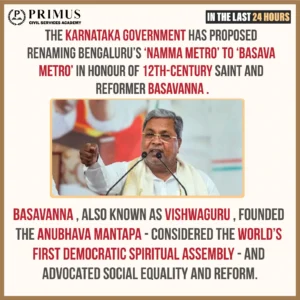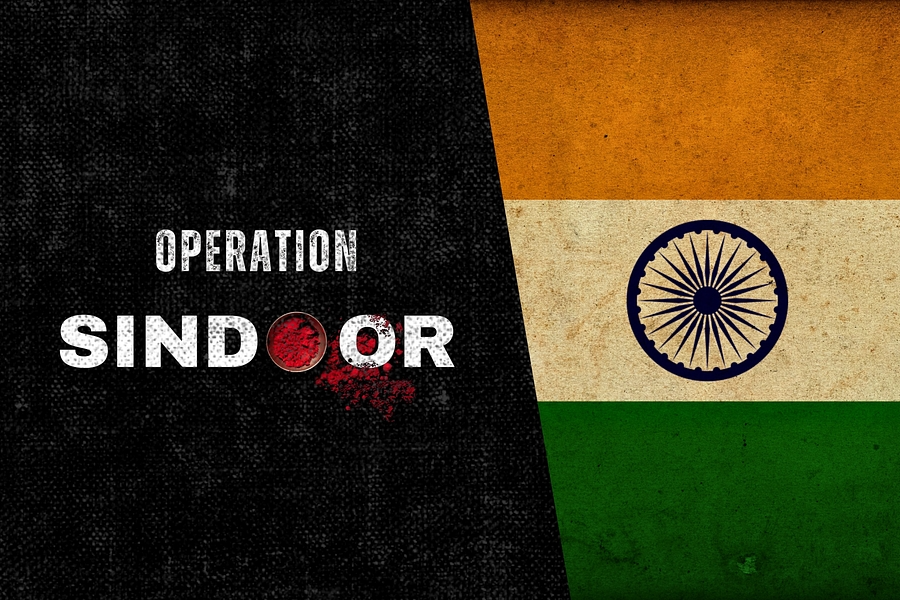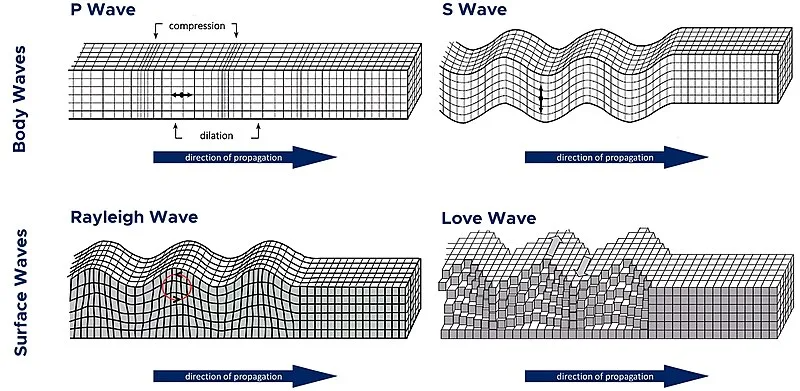October 06th Current Affairs
Table of Contents
Kannada Literature Optional Syllabus
Home / ಐಚ್ಚಿಕ ಕನ್ನಡ ಸಾಹಿತ್ಯದ ಪಠ್ಯಕ್ರಮ ಐಚ್ಚಿಕ ಕನ್ನಡ ಸಾಹಿತ್ಯ ಪತ್ರಿಕೆ – 1 ವಿಭಾಗ – ಎ ಅ) ಕನ್ನಡ ಭಾಷೆಯ ಚರಿತ್ರೆ ಭಾಷೆ
UPSC Current Affairs – October 6th
October 06th Current Affairs Home / Table of Contents 36-hour curfew imposed in parts of Odisha’s Cuttack over communal tensions
Religious Minorities in India and the Challenge of Communal Harmony: A Sociological Reflection on the Cuttack Violence
Home / Religious Minorities in India and the Challenge of Communal Harmony: A Sociological Reflection on the Cuttack Violence Sociology
UPSC Current Affairs – October 4th
October 04th Current Affairs Home / Table of Contents Isabgol Processors threaten to halt purchases from October 6th over GST
Sologamy and Contemporary Trends in Marriage: A Sociological Perspective
Home / Sologamy and Contemporary Trends in Marriage: A Sociological Perspective Sociology Paper 1: Systems of Kinship – Contemporary trends
UPSC Current Affairs – October 3rd
October 03rd Current Affairs Home / Table of Contents NASA IMAP to show how solar particles are energised and shield
Understanding Indian Festivals through Durkheim: Religion, Rituals, and Collective Conscience
Home / Understanding Indian Festivals through Durkheim: Religion, Rituals, and Collective Conscience Sociology Paper 1: Émile Durkheim – Religion and
UPSC Current Affairs – September 30th
September 30th Current Affairs Home / Table of Contents Ladakh groups reject talks with government, Ministry says open to dialogue
Caste Census in India: A Sociological Perspective
Home / Caste Census in India: A Sociological Perspective Sociology Paper 2: Caste System – Features of Caste system. The
Constitutional Morality: Upholding India’s Democratic Ethos
Home / Constitutional Morality: Upholding India’s Democratic Ethos Sociology Paper 2: Visions of Social Change in India – Constitution, law,
36-hour curfew imposed in parts of Odisha’s Cuttack over communal tensions

Relevance to UPSC
GS Paper II Polity Governance and Social Justice:
- Centre–State Relations / State Government Responsibilities (law & order is a core state subject)
- Rights & Liberties (internet / social media shutdowns and freedom of speech)
GS Paper III: Internal Security:
- Internal Security Challenges (communal clashes, crowd control, riot management)
More About the News
- During the Durga Puja idol immersion in Cuttack, Odisha, clashes erupted (reportedly over loud music) between procession participants and the local residents, stones and bottles were thrown, several were injured (including a DCP) and around six arrests made.
- In response, the state government imposed a curfew (36 hours) across affected zones, suspended internet / social media services for 24 hours, deployed heavy security forces, and called prohibitory orders.
- The Vishwa Hindu Parishad (VHP) has called a 12-hour bandh in Cuttack protesting what it terms administrative failure in maintaining law and order during the festival.
Communalism
Communalism represents the exploitation of religious identities to create social divisions and political gain, often undermining secular and democratic values. In India, its historical roots trace back to colonial policies, partition, and post-independence socio-political events, which institutionalized communal consciousness. Understanding its causes, forms, and impacts is essential to safeguard social harmony, national integration, and inclusive development.
Understanding Communalism – Causes, Forms and Impact
- Ideology of Division: Communalism views society as rigid religious groups with conflicting interests, fostering an “us vs. them” mentality and distrust.
- Spectrum of Communalism: Ranges from mild alignment of interests to extreme hostility, causing political polarisation and violence.
- Religious Supremacy: At its extreme, religious identity is prioritized over democratic and national values, promoting intolerance and exclusion.
- Political Weaponisation: Exploited for electoral gains; politicians manipulate religious sentiments to consolidate vote banks, deepening societal divisions.
- Impact on Social Harmony: Weakens secularism, interfaith cooperation, and national integration, leading to riots, mistrust, and long-term instability.
- Role of Media & Propaganda: Hate speech, misinformation, and biased narratives exacerbate communal tensions, complicating conflict resolution.
Types of Communalism
- Assimilationist: Pushes minority groups to adopt dominant religious customs, risking loss of identity (e.g., debates on Uniform Civil Code).
- Welfarist: Focuses on religiously targeted welfare schemes, reinforcing sectarian identities (e.g., minority scholarships, Waqf boards).
- Retreatist: Encourages withdrawal from mainstream political/social life due to religious beliefs (e.g., certain Jain or Baha’i practices).
- Retaliatory: Arises from mutual hostility, creating cycles of revenge and violence (e.g., 1984 Anti-Sikh riots, 2002 Gujarat riots).
- Separatist: Demands a separate religious-based state or regional autonomy, challenging national unity (e.g., Sikh state demand 1953, J&K autonomy).
- Secessionist: Advocates complete separation from the nation, often through violence (e.g., Khalistan movement, Bangladesh Liberation 1971).
Communalism in India – Historical Evolution
- Colonial Policies: British “divide and rule” policies, like separate electorates (Morley-Minto Reforms, 1909), institutionalized communal identities.
- Partition of Bengal (1905): Dividing Bengal along religious lines caused protests; reversed in 1911.
- Communal Award (1932): Separate electorates for minorities & depressed classes; led to Poona Pact between Gandhi and Ambedkar.
- Rise of Communal Organizations: Muslim League (1906), Hindu Mahasabha (1915), and RSS (1925) promoted religious mobilization.
- Partition and Aftermath (1947): Creation of India and Pakistan caused over 1 million deaths and displacement of 15 million people.
- Post-Independence Events: Shah Bano case (1985), Babri Masjid demolition (1992), Gujarat riots (2002) deepened communal divides.
Impact of Communalism in India
- Erosion of Law & Order: Communal tensions escalate into violence; NCRB (2021) recorded 378 communal riots affecting 500+ victims.
- Violation of Fundamental Rights: Marginalized groups face killings, displacement, and property destruction, violating Articles 21 & 25.
- Fractured Social Fabric: Religious polarization weakens pluralism; Pew Research (2023) shows only 42% Indians trust people from other religions.
- Economic Disruptions: Violence damages infrastructure, affects businesses, and deters investment; Global Peace Index (2022) estimates 6% GDP loss annually.
- Obstruction to National Development: Resources diverted from education, healthcare, and infrastructure due to communal conflicts.
- Global Reputation at Stake: Rising religious intolerance flagged by USCIRF (2023), affecting India’s international standing.
Way Forward
- Strict Enforcement of Constitutional Provisions: Uphold Articles 14, 15, 19, 21, 25–28 to ensure equality, religious freedom, and secular governance.
- Strengthen Anti-Communal Laws & Judicial Oversight: Introduce comprehensive anti-communal violence laws, fast-track courts, and strict penalties.
- Curb Hate Speech & Misinformation: Regulate social and mainstream media under IT Rules 2021 to prevent inflammatory content.
- Political Accountability & Electoral Reforms: Penalize candidates exploiting religion for votes; enforce Representation of People Act, 1951.
- Inclusive Education & Social Awareness: Promote interfaith harmony, constitutional values, and civic education from early schooling.
- Strengthen Law Enforcement & Governance: Police reforms, impartial handling of communal violence, and diversity in law enforcement.
- National Integration & Community Engagement: Expand initiatives like Ek Bharat Shreshtha Bharat, strengthen Panchayats and urban local bodies for interfaith dialogue.
As Jawaharlal Nehru said, “We cannot encourage communalism or narrow-mindedness, for no nation can be great whose people are narrow in thought or action.” To eradicate communalism and safeguard India’s pluralistic identity, it is essential to strengthen constitutional safeguards, promote social harmony, and ensure political accountability.
Prelims MCQ
Q. Which of the following statements regarding communalism in India is/are correct? 1. The Communal Award of 1932 granted separate electorates to minorities and depressed classes. 2. The Babri Masjid demolition in 1992 was a post-independence event that deepened communal divides in India. 3. The Uniform Civil Code is an example of retaliatory communalism. 4.British policies like the Morley-Minto Reforms (1909) contributed to the institutionalization of communal identities.
A. 1, 2, and 4 only
B. 2 and 3 only
C. 1 and 3 only
D. All of the above
Mains Question
Q. Distinguish between religiousness/religiosity and communalism giving one example of how the former has got transformed into the latter in independent India (PYQ 2017)
Sonam Wangchuk demands independent judicial inquiry into civilian deaths in Leh: lawyer

Relevance to UPSC
GS Paper II: Constitution & Governance
- Government policies and interventions for development in various sectors and issues arising out of their design and implementation
GS Paper III: Internal Security
- Security challenges and their management in Border Areas; linkages of organized crime with terrorism
More About the News
- Sonam Wangchuk, a prominent Ladakhi activist and engineer, has called for an independent judicial inquiry into the recent deaths of civilians in Leh, alleging human rights violations and misuse of power.
- The deaths occurred during a period of heightened tensions in the region, with reports indicating possible misuse of force by security personnel during protests or unrest.
- The call for an independent inquiry has garnered support from local communities and human rights organizations, emphasizing the need for accountability and transparency in handling such sensitive matters.
Gandhian Principles of Conflict Resolution
Gandhian principles, rooted in truth, nonviolence, and social justice, continue to inspire India’s democratic ethos. They guide governance, ethical conduct, and policy-making, particularly in realizing the ideals enshrined in the Constitution.
Conflicts and Conflict Resolution
Types of Conflicts: Interpersonal, legal, industrial, social/national, international.
Causes: Traditional, emerging, or perceived changes; incompatibilities; clash of interests, beliefs, values, egos, or goals.
Nature: Not always destructive; can be a symptom or release of tension; may be manifest or underlying.
Resolution of Conflicts:
- Occurs when disputants abandon hope of further change.
- Costs: Economic, social, psychological.
Methods of Resolution:
- Coercion: Imposed by power disparities; unilateral, competitive.
- Avoidance / ‘Lumping’: Withdrawal due to powerlessness or lack of alternatives; unilateral, competitive.
- Negotiation: Bilateral, cooperative; seeks mutually preferred terms.
- Mediation: Third-party assistance; cooperative; no decision-making power.
- Arbitration & Adjudication: Parties submit to a third party’s decision; competitive, zero-sum.
Outcomes:
- Productive Conflicts: Mutual satisfaction, cooperation, trust, goodwill, dialogue, nonviolence.
- Destructive Conflicts: “Winner takes all”, resentment, escalation, coercion, threats, rigid positions, deception, violence.
Gandhian Philosophy: Satyagraha
Violent Conflict: Denial of truth; destructive; generates vengeance.
Nonviolent Conflict: Focus on accommodation and conversion of opponent; moral appeal; reduces resentment.
Definition:
- Satyagraha = Satya (Truth) + Graha (Insistence/Firmness)
- Also called Truth-force / Soul-force.
Essence:
- Not passive resistance; differs from coercion.
- Applicable from interpersonal to international conflicts.
- Fundamental unit: Individual; personal moral growth is key.
Principles of Satyagraha
- Truth (Satya): Ultimate moral reality; no coercion to impose personal view of truth.
- Nonviolence (Ahimsa): Means to achieve truth; active love for the wrongdoer; not passive tolerance.
- Creative Self-Suffering: Appeals to opponent’s conscience; transforms both parties; minimal harm.
- Faith in Human Goodness: Opponent can respond to reason; optimism in human potential.
- Means and Ends: Right means ensure proper ends; purity of method is crucial.
- Fearlessness: Courage in defense; violence is not a moral solution.
Role of an Individual
- Individuals are the building blocks of Satyagraha.
- Personal moral development influences social transformation.
- Mass movements rely on disciplined individuals.
- Excessive concentration of state power can inhibit nonviolent action.
Psychology of Satyagraha
- Aggression vs. Violence: Natural self-assertion is different from destructive violence.
- Human Will: Free will exists; individuals can choose nonviolence and moral action.
- Patience: Essential for sustained nonviolent action; contrasts with violent approaches seeking quick results.
- Training: Cultivation of truthfulness, tolerance, humility, loving-kindness.
Applications of Satyagraha
- Interpersonal Conflicts:
- Practice nonviolence in daily life; replace fear with trust.
- Avoid rigid positions; understand opponent’s perspective.
2. Legal Disputes:
- Courts resolve conflicts formally; Satyagraha emphasizes dialogue, mediation, and reconciliation.
- Civil resisters voluntarily accept penalties to maintain moral high ground.
3. Industrial Conflicts:
- Labour treated as co-owners; equality with capital.
- Strikes are last resort after negotiation, arbitration, and reconciliation.
- Conduct: Nonviolence, honesty, courage, self-reliance.
- Civil disobedience may be used for local grievances; constructive work complements mass Satyagraha.
- Trusteeship: Rich act as moral stewards of wealth; conversion over coercion.
4. Political Conflicts: Civil Disobedience
- Nonviolent opposition to unjust laws.
- Principles: Open, respectful, restrained, voluntary acceptance of penalty.
- Must exhaust negotiation and established channels before Satyagraha.
- Moral pressure and public opinion aim to convert opponents.
5. Inter-nation Conflicts:
- Nonviolent defense prioritizes conversion over harm.
- Modern war and nuclear threats complicate defense; solution lies in disarmament, conciliation, economic support.
- Civilian resistance: Offer non-cooperation and nonviolent defiance to aggressors.
Ethics and Lifestyle of Satyagrahi
- Dialogue, listening, and respect for opponents are crucial.
- Goal: Truth / Moksha (self-realization).
- Avoidance of evil; promotion of good actively.
- Freedom, ethical living, patience, humility, moral courage emphasized.
- Effort is victory; attainment is secondary.
Key Takeaways
- Satyagraha transforms conflicts from destructive to constructive.
- Individual morality is the foundation for social and political change.
- Means matter as much as ends; nonviolence is active, disciplined, and strategic.
- Satyagraha can be applied at personal, legal, industrial, political, and international levels.
Integrating Gandhian ideals with modern governance can strengthen ethical leadership, social equity, and sustainable development, fostering a resilient democracy that resolves conflicts nonviolently and empowers citizens responsibly.
Prelims MCQ
Q. Which of the following Gandhian principles have been explicitly incorporated in the Directive Principles of State Policy (DPSP) under the Indian Constitution? 1. Promotion of cottage industries and self-reliance 2. Nonviolence and renunciation of exploitation 3. Equal pay for equal work for men and women 4. Trusteeship for equitable distribution of wealth
A. 1,2 & 3
B. 2,3 & 4
C. 1,2 & 4
D. All of the above
Mains Question
Q. Examine how the incorporation of Gandhian principles in the Directive Principles of State Policy contributes to social justice and conflict resolution in contemporary India. Illustrate with examples.
Indian Navy set to Commission Androth- A steady march with new Indigenious Inductions

Relevance to UPSC
GS Paper III: Defence Technology
- The development and induction of INS Androth showcase advancements in naval technology and the application of indigenous engineering solutions.
More About the News
- The Indian Navy is set to commission INS Androth, the second Anti-Submarine Warfare Shallow Water Craft (ASW-SWC), at a ceremony on October 6, 2025, at the Naval Dockyard, Visakhapatnam.
- Built by Garden Reach Shipbuilders and Engineers (GRSE), Kolkata, INS Androth boasts over 80% indigenous content, reflecting India’s growing maritime self-reliance.
- The commissioning underscores the Navy’s commitment to enhancing indigenous capability through innovative technologies and homegrown solutions.
INS Androth
INS Androth, the second Anti-Submarine Warfare Shallow Water Craft (ASW-SWC) commissioned into the Indian Navy, marks a significant advancement in India’s maritime capabilities. Built indigenously by Garden Reach Shipbuilders and Engineers (GRSE), Kolkata, this vessel underscores the nation’s commitment to self-reliance and enhanced naval defense.
Key Features of INS Androth
Advanced Sonar Systems
- Equipped with the Abhay compact active hull-mounted sonar and a towed low-frequency variable-depth sonar, Androth can detect, track, and classify underwater threats with precision.
Indigenous Construction:
- With over 80% indigenous content, the ship incorporates equipment from Indian manufacturers like Bharat Electronics, Mahindra Defence, and Larsen & Toubro, reflecting India’s push for ‘Aatmanirbhar Bharat’.
Enhanced Propulsion System:
- The vessel is powered by three marine diesel engines coupled with water jets, offering a maximum speed of 25 knots and a range of 1,800 nautical miles at 14 knots.
Multi-Role Capability:
- Designed for various missions, including anti-submarine warfare, search and rescue, and low-intensity maritime operations, Androth enhances the Navy’s operational flexibility.
Strategic Naming:
- Named after Androth Island in the Lakshadweep archipelago, the ship emphasizes India’s commitment to safeguarding its maritime territories.
Strategic Importance
Enhanced Coastal Defense:
- Operating in shallow coastal waters, Androth strengthens India’s ability to monitor and protect its extensive coastline from underwater threats.
Deterrence Against Submarine Threats
- The vessel’s advanced sonar and weapon systems provide a formidable deterrent against potential adversaries’ submarine incursions in the Indian Ocean Region.
Support for Maritime Patrol Aircraft
- Androth’s capabilities complement those of maritime patrol aircraft, enabling coordinated anti-submarine operations and enhancing overall maritime surveillance.
Contribution to ‘Aatmanirbhar Bharat’
- By incorporating a high percentage of indigenous components, the ship aligns with India’s vision of self-reliance in defense manufacturing.
Legacy and Continuity
- The commissioning of Androth honors the legacy of its predecessor, INS Androth (P69), which served the nation for over 27 years, ensuring continuity in maritime defense capabilities.
Challenges in Building Such Facilities
- Technological Complexity
- Developing advanced sonar and propulsion systems requires cutting-edge technology and expertise, posing challenges in research and development.
- Developing advanced sonar and propulsion systems requires cutting-edge technology and expertise, posing challenges in research and development.
- Integration of Indigenous Components
- Ensuring compatibility and reliability of various indigenous components from different manufacturers demands rigorous testing and quality control.
- Ensuring compatibility and reliability of various indigenous components from different manufacturers demands rigorous testing and quality control.
- Skilled Workforce Requirement
- The construction and maintenance of such sophisticated vessels necessitate a highly skilled workforce, requiring continuous training and development.
- The construction and maintenance of such sophisticated vessels necessitate a highly skilled workforce, requiring continuous training and development.
- Infrastructure Development
- Establishing state-of-the-art shipbuilding facilities and testing centers involves significant investment in infrastructure and resources.
- Establishing state-of-the-art shipbuilding facilities and testing centers involves significant investment in infrastructure and resources.
- Supply Chain Coordination
- Coordinating the supply of materials and components from various sources to meet project timelines can be challenging, especially during global supply chain disruptions.
Government Initiatives
- ‘Aatmanirbhar Bharat’ Campaign
- Promotes self-reliance in defense manufacturing, encouraging indigenous production of military hardware.
- Promotes self-reliance in defense manufacturing, encouraging indigenous production of military hardware.
- Support for Shipbuilding Industry
- Provides financial incentives and policy support to domestic shipbuilders to enhance their capabilities.
- Provides financial incentives and policy support to domestic shipbuilders to enhance their capabilities.
- Technology Transfer Agreements
- Facilitates partnerships with foreign firms to acquire advanced technologies and integrate them into domestic production.
- Facilitates partnerships with foreign firms to acquire advanced technologies and integrate them into domestic production.
- Skill Development Programs
- Initiates training programs to develop a skilled workforce adept in modern shipbuilding techniques.
- Initiates training programs to develop a skilled workforce adept in modern shipbuilding techniques.
- Infrastructure Modernization
- Invests in upgrading shipyards and testing facilities to meet the demands of advanced naval construction.
Way Forward
- Expansion of Indigenous Production
- Research and Development Focus
- International Collaboration
- Enhanced Training Programs
- Modernization of Naval Infrastructure
The commissioning of INS Androth signifies a pivotal step in India’s journey towards a self-reliant and technologically advanced naval force. By integrating indigenous technologies and focusing on strategic maritime defense, India is poised to enhance its security posture in the Indian Ocean Region. Continued investment in innovation and infrastructure will be crucial in maintaining maritime dominance.
Prelims MCQ
Q. Which of the following is true about INS Androth?
A. It is the first ship of the Anti-Submarine Warfare Shallow Water Craft class.
B. It is built by Garden Reach Shipbuilders and Engineers, Kolkata.
C. It has over 90% indigenous content.
D. It is named after a city in the Andaman and Nicobar Islands.
a) Incorrect. INS Arnala is the first ship of the ASW-SWC class. b) Correct. INS Androth was built by Garden Reach Shipbuilders and Engineers, Kolkata. c) Incorrect. INS Androth has over 80% indigenous content, not 90%. d) Incorrect. INS Androth is named after Androth Island in the Lakshadweep archipelago, not a city in the Andaman and Nicobar Islands.
Mains Question
Q. “Discuss the strategic significance of INS Androth in enhancing India’s maritime security capabilities, considering its indigenous development and operational roles in the Indian Ocean Region.”
Sanae Takichi set to become Japan’s First Female Prime Minister

Relevance to UPSC
GS Paper II: Governance, Constitution & International Relations
- Takaichi’s leadership marks a significant policy shift in Japan, with potential implications for governance and development strategies.
- Takaichi’s foreign policy approach, including her stance on Taiwan and relations with China, will influence Japan’s international relations, impacting India’s strategic interests in the Asia-Pacific region.
More about the News
- Sanae Takaichi, former Economic Security Minister, has been elected as the leader of Japan’s ruling Liberal Democratic Party (LDP), positioning her to become the country’s first female prime minister.
- Takaichi secured 185 votes in a runoff against Agriculture Minister Shinjiro Koizumi, who received 156 votes, following the resignation of Prime Minister Shigeru Ishiba.
- Known for her ultra-conservative stance and admiration for former British Prime Minister Margaret Thatcher, Takaichi is expected to lead Japan through a period of political instability and rising regional tensions.
Comparison of the Constitutions of India and Japan
Japan’s first constitution, known as the Meiji Constitution, was enacted in 1889 and is recognized as Asia’s first Western-style constitution. Its formulation was significantly influenced by the Prussian Constitution of the 1850s. Following the opening of Japan to Western countries in 1854, ideas of constitutionalism, along with broader aspects of Western culture, technology, and thought, began to permeate Japanese society, laying the foundation for modern governance and legal frameworks.
Features of the Japanese Constitution
- It was a rigid and written constitution.
- The emperor’s sovereignty was considered inviolable and sacred.
- The Parliament consisted of two houses: the House of Representatives and the House of Peers.
- Legislative power was exercised only with the consent of the Imperial Diet.
- Judicial power was exercised in the name of the emperor.
- Courts had no authority over administrative matters.
Comparison: Japanese Constitution and Indian Constitution
- One key feature adopted in the Indian Constitution from Japan is the “procedure established by law” related to the right to personal liberty and life.
- In the Japanese Constitution, Article 31 emphasized the right to personal liberty and life, stating that no criminal liability could be imposed without following the legal procedure.
- Similarly, Article 21 of the Indian Constitution guarantees that no person shall be deprived of personal liberty or life except according to the procedure established by law, preserving the principles of natural justice.
- In Japan, Articles 32–38 collectively protected natural rights through court interpretations, influencing India’s adoption of a similar legal safeguard.
Japanese Constitution: Article 9
- Article 9 prohibits Japan from engaging in war to resolve international disputes.
- Enforced on 3 May 1947 (post-World War II), this article forms part of the Japanese Constitution of 1947.
- The state renounces war, the maintenance of war potential armed forces, and the sovereign right of belligerency, aiming to uphold international peace based on justice and order.
- The constitution was imposed during the US occupation of Japan after World War II.
The Indian Constitution
- Came into force on 26th January 1950.
- At adoption, it had 395 articles in 22 parts and 8 schedules; additional articles and parts were added later through amendments.
- Originally 145,000 words long, making it the longest national constitution ever adopted.
- Currently, it contains 12 schedules.
- Repealed articles and amendments to the Preamble are specifically noted in the Constitution.
Characteristics of the Indian Constitution
- Longest and most detailed constitution in the world.
- Based on Government of India Act, 1935: Features like judiciary, federal scheme, emergency powers, governors, administrative details, and public service commissions were derived from it.
- Federal system with unitary features: Dual system of government—Centre and States.
- Separation of powers: Authority divided among legislature, executive, and judiciary.
- Independent authority: India is free from external domination.
- Legislature’s supremacy: Only the legislature can make laws, subject to constitutional limitations.
- Established form of democracy: People exercise rights through voting in elections.
- Secular character: Declared by the 42nd Amendment (1976) in the Preamble.
- Meaning of secularism: All religions in India receive equal protection, respect, and support from the state.
What are the Borrowed Features of the Indian Constitution?
Source | Features Borrowed |
Government of India Act, 1935 | Federal structure, office of the Governor, judiciary, public service commissions, emergency provisions, administrative details |
British Constitution | Parliamentary system, rule of law, legislative procedures, single citizenship, cabinet system, prerogative writs, parliamentary privileges, bicameral legislature |
US Constitution | Fundamental rights, independence of judiciary, judicial review, impeachment of the President, removal of Supreme Court and High Court judges, office of the Vice-President |
Irish Constitution | Directive Principles of State Policy, nomination of members to Rajya Sabha, method of presidential election |
Canadian Constitution | Federation with a strong centre, vesting of residuary powers in the centre, appointment of state governors by the centre, advisory jurisdiction of the Supreme Court |
Australian Constitution | Concurrent list, freedom of trade, commerce, and intercourse, joint sitting of both houses of Parliament |
Weimar Constitution (Germany) | Suspension of fundamental rights during emergency |
Soviet Constitution (USSR, now Russia) | Fundamental duties, ideal of justice (social, economic, political) reflected in the Preamble |
French Constitution | Republic, and ideals of liberty, equality, and fraternity in the Preamble |
South African Constitution | Procedure for constitutional amendments, election of members of Rajya Sabha |
Japanese Constitution | “Procedure established by law” related to personal liberty and life |
Similarities Between the Indian and Japanese Constitutions
- Written Constitutions:
- Both India and Japan have written constitutions, providing a clear framework for governance.
- Enactment: Indian Constitution (1950), Japanese Constitution (1947).
- Legislative Framework:
- Supreme Legislative Body: Parliament is the highest legislative authority in both countries.
- Bicameral Legislature:
- India: Rajya Sabha (Upper House) & Lok Sabha (Lower House)
- Japan: House of Councillors (Upper House) & House of Representatives (Lower House)
- No-Confidence Motion: In both countries, the lower house can dissolve the government through a vote of no confidence.
- Parliamentary Terms:
- Members of Japan’s House of Councillors serve six-year terms, with half retiring every three years, similar to India’s Rajya Sabha.
- Members of Japan’s House of Councillors serve six-year terms, with half retiring every three years, similar to India’s Rajya Sabha.
- Philosophical and Legal Elements:
- Judicial and Constitutional Review: Supreme Courts in both nations have the power of judicial review.
- Legal Procedures: Both follow law-based procedures rather than discretionary rule.
- Executive Structure:
- Prime Minister: Can be a member of either house in both countries.
- Council of Ministers: Accountable to the lower house in both India and Japan.
- Judicial Structure:
- Judicial Appointment and Removal: Judges have fixed retirement ages, and their appointment/removal follows established legal procedures in both countries.
Differences Between the Indian and Japanese Constitutions
- Constitutional Rigidity
- India: Constitution is both rigid and flexible, allowing amendments via special or simple majority.
- Japan: Constitution is rigid, requiring a public referendum for amendments.
- State Structure:
- India: Federal state, with power divided between Union and State governments.
- Japan: Unitary state, with all power concentrated in the central government.
- Executive Setup:
- Ministerial Appointments:
- India: Ministers appointed by the President on PM’s advice.
- Japan: Ministers do not require presidential appointment.
- Prime Minister Election:
- India: Leader of the majority party, appointed by the President.
- Japan: Elected directly by Parliament (Diet).
- Ministerial Appointments:
- Political Framework:
- Government Type:
- India: Republic, with President as constitutional head.
- Japan: Constitutional monarchy, with Emperor as ceremonial head.
- Treaty Ratification:
- India: Executive can approve treaties without parliamentary ratification.
- Japan: All treaties require approval from the Diet (Parliament).
- Government Type:
- Judicial Appointments:
- India: Judges appointed by the President in consultation with judiciary; Parliament has no role.
- Japan: Judges appointed by the Diet, giving the legislature more influence.
The Indian and Japanese Constitutions both embody democratic principles, highlighting parliamentary supremacy, judicial review, and accountability of the executive. Despite these similarities, they differ notably in structure and governance. India operates as a federal parliamentary republic with a flexible amendment process, whereas Japan functions as a unitary state with a rigid constitution under a constitutional monarchy. These differences reflect the distinct historical, cultural, and political contexts of the two nations.
Prelims MCQ
Q.
Other than the Fundamental Rights, which of the following parts of the Constitution of India reflect the principles and provisions of the Universal Declaration of Human Rights (1948)? (PYQ 2020)
1. Preamble
2. Directive Principles of State Policy
3. Fundamental Duties
Select the correct answer using the code given below:
A. A Democratic Republic
B. A Sovereign Democratic Republic
C. A Sovereign Secular Democratic Republic
D. A Sovereign Socialist Secular Democratic Republic
On 26th January 1950, India became sovereign, meaning it had full authority over its internal and external affairs. It was a democratic republic, adopting a system where the head of state is elected, not hereditary. The terms secular and socialist were added later through constitutional amendments (42nd Amendment, 1976).
Mains Question
Q. What can France learn from the Indian Constitution’s approach to Secularism? (PYQ 2019)
Namma Metro gone? Karnataka proposes to rename Bengaluru metro as 'Basava Metro'

Relevance to UPSC
GS Paper I: History
- Bhakti Movement, Basavanna and his contributions to the society
GS Paper II: Governance
- Government policies and interventions for development in various sectors and issues arising out of their design and implementation
More about the News
- Karnataka Chief Minister Siddaramaiah has proposed to the central government to rename Bengaluru’s Namma Metro as Basava Metro, in honor of the 12th-century social reformer Basavanna.
- Basavanna, revered as Vishwaguru Basavanna, founded the Anubhava Mantapa, the first democratic spiritual assembly, and championed equality and social reform.
- The state government has taken steps to honor Basavanna’s legacy, including declaring him the “Cultural Leader of Karnataka” in January 2024 and mandating his portrait in all government offices.
Basavanna
Basavanna, a 12th-century philosopher, poet, and social reformer, spearheaded a transformative movement in Karnataka, advocating equality, social justice, and rational devotion through the Lingayat faith. His revolutionary ideas challenged caste hierarchies, ritualism, and gender discrimination, leaving a lasting imprint on Indian society. By emphasizing inner spirituality, community service, and education in the vernacular, he laid the foundation for a more inclusive social order.
About Basavanna (1131–1167)
- Also known as Basaveshwara, he was a philosopher, poet, social reformer, and saint of the Shiva-centered Bhakti movement.
- Born in Basavana Bagewadi, Karnataka, in a devout Kannada Brahmin family.
- Influential during the reign of Kalyani Chalukya and Kalachuri dynasties, particularly under King Bijjala.
- Led a reformist anti-caste movement, rejecting orthodox Hindu rituals and emphasizing personal devotion to Shiva.
Key Contributions
Religious & Spiritual Contributions:
- Introduced the Ishtalinga, a necklace with a lingam, as a symbol of devotion accessible to all, irrespective of caste or status.
- Advocated inner spirituality, treating body and soul as temples, over external rituals.
- Promoted Lingayat theology: qualified nondualism where Atma (soul) is Shiva, removing the distinction between God and individual soul.
- Emphasized six-syllable mantra “Shivaya Namah” and the trinity of guru, linga, and jangama.
Socio-Economic Principles:
- Kayaka (Divine Work): Encouraged performing one’s vocation with dedication, seeing work as worship.
- Dasoha (Service/Equal Distribution): Urged sharing wealth, effort, and service with the community and religious mendicants (Jangamas).
Basavanna Anubhava Mantapa:
- Founded in the 12th century, Basavakalyan, Karnataka, it is known as the world’s first religious parliament.
- It is a platform for mystics, saints and philosophers to discuss spiritual and social issues.
- Presided by Allama Prabhu; key contributors included Akka Mahadevi, Channabasavanna and Basavanna.
- Originated the Vachana literature, spreading the Veerashaiva philosophy.
Literary Contributions:
- Composed Vachanas: simple, direct prose in Kannada addressing devotion, social equality, and criticism of caste and rituals.
- Notable works: Shat-sthala-vachana, Kala-jnana-vachana, Mantra-gopya, Ghatachakra-vachana, Raja-yoga-vachana.
- Contributed to the Sharana movement, a social-religious reform movement promoting egalitarianism.
Social Reforms:
- Advocated equality, rejecting caste and gender discrimination.
- Promoted Ahimsa (non-violence), rejecting human and animal sacrifices.
- Encouraged inclusivity, literacy in Kannada for spiritual accessibility.
- Challenged orthodox norms, e.g., organized inter-caste weddings.
Philosophy Highlights:
- Emphasized inner devotion over rituals.
- Encouraged personal spiritual growth as a path to enlightenment.
- Advocated rationality, freedom, and brotherhood as pillars of social order.
Legacy & Memorials:
- Life chronicled in Basava Purana (13th century) by Palkuriki Somanatha.
- Honored with statues:
- 2003: Statue in Indian Parliament.
- 108-ft statue in Basavakalyan.
- 111-ft Vishwa Guru Basaveshwara statue in Gadag.
- Inspired the Bharat Mandapam (2023), modeled after his Anubhava Mantapa.
Way Forward
- Promote Social Equality
- Encourage Community Service (Dasoha)
- Emphasize Education in Vernacular Languages
- Foster Ethical and Vocational Work Culture (Kayaka)
- Integrate Values into Governance
- Promote Interfaith and Inclusive Dialogues
- Preserve and Popularize Cultural Heritage
Basavanna’s vision of an egalitarian and spiritually enriched society continues to inspire contemporary social reforms. By embracing his principles of equality, rationality, and community service, modern India can foster inclusive growth and social harmony. Continued promotion of his teachings will strengthen the moral and cultural foundations of the nation.
Prelims MCQ
Q. With reference to the religious history of medieval India, the Sufi mystics were known to pursue which of the following practices? (PYQ 2012)
1. Meditation and control of breath
2. Severe ascetic exercises in a lonely place
3. Recitation of holy songs to arouse a state of ecstasy in their audience
Select the correct answer using the codes given below:
A. 1 and 2 only
B. 2 and 3 only
C. 3 only
D. All of the above
Sufi mystics practiced meditation and breath control to achieve spiritual discipline and inner purity. They engaged in ascetic exercises in solitude to detach from worldly distractions and focus on God. They also used holy songs (Qawwali, Sama) to induce spiritual ecstasy and devotion among followers.
.Mains Question
Q. Evaluate the nature of Bhakti Literature and its contribution to Indian Culture (PYQ 2021)




